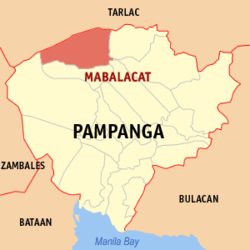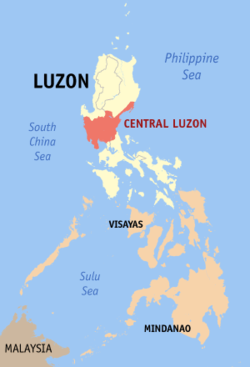Mabalacat
| Mabalacat | ||
|---|---|---|
| Component City | ||
|
Mabalacat City Hall | ||
| ||
 Map of Pampanga showing the location of Mabalacat | ||
.svg.png) Mabalacat Location within the Philippines | ||
| Coordinates: 15°13′N 120°35′E / 15.217°N 120.583°ECoordinates: 15°13′N 120°35′E / 15.217°N 120.583°E | ||
| Country | Philippines | |
| Region | Central Luzon (Region III) | |
| Province | Pampanga | |
| District | 1st District | |
| Founded | 1712 | |
| Cityhood | July 21, 2012 | |
| Barangays | 27 | |
| Government[1] | ||
| • Mayor | Marino P. Morales (Lakas Kampi CMD) | |
| • Vice Mayor | Christian Halili (IND) | |
| Area[2] | ||
| • Total | 83.18 km2 (32.12 sq mi) | |
| Population (2015)[3] | ||
| • Total | 250,799 | |
| • Density | 3,000/km2 (7,800/sq mi) | |
| Time zone | PST (UTC+8) | |
| ZIP code | 2010 | |
| Dialing code | +63 (0)45 | |
| Income class | 1st class | |
| Website |
mabalacatcity | |
Mabalacat, officially the City of Mabalacat (Kapampangan: Lakanbalen ning Mabalacat; Filipino: Lungsod ng Mabalacat) or simply referred to as Mabalacat City, is a component city in the northern part of the province of Pampanga in Central Luzon, Philippines. The former municipality was officially converted into a city following a referendum on July 21, 2012 and became the third in Pampanga after Angeles City and San Fernando. According to the 2010 census, it has a population of 215,610 people.[4]
The city's name is derived from indigenous Negrito word mabalacat meaning "forest of balacats".
Mabalacat has a land area of 83.18 square kilometres (32.12 sq mi).[2] Roughly 60% of the Clark Freeport Zone is located in Mabalacat, the rest in nearby Angeles City, where the Clark main gate is located and which is served by the Clark International Airport with its numerous hotels, casinos, golf courses, and resorts.[5]
The soil is charcoal black and shiny, a sign of fertility, and is suitable for growing rice, sugarcane and other rootcrops. Like the neighbouring cities of Angeles and San Fernando and the towns/municipalities of Porac, Bacolor, Santa Rita, Mexico, Magalang and Arayat, this city never gets inundated by floods from heavy rains and typhoons because it is situated on an elevated, well-drained plain known as the "Upper Pampanga".
Barangays
Mabalacat is politically subdivided into 27 barangays.[2]
- Atlu-Bola
- Bical
- Bundagul
- Cacutud
- Calumpang
- Camachiles
- Dapdap
- Dau
- Dolores
- Duquit
- Lakandula
- Mabiga
- Macapagal Village
- Mamatitang
- Mangalit
- Marcos Village
- Mawaque (Mauaque)
- Paralayunan
- Poblacion
- San Francisco
- San Joaquin
- Santa Ines
- Santa Maria
- Santo Rosario
- Sapang Balen
- Sapang Biabas
- Tabun
The largest barangay is Dau, which became a barrio in 1936 by virtue of Presidential Proclamation Number 1. It is now a business center whose commercial output runs parallel to that of downtown. A former terminus of the North Luzon Expressway, it is the most urban and most populous area in Mabalacat, home to roughly 23% of the city's population.
San Francisco, the second largest barangay, along with San Joaquin, Santa Ines, Poblacion, Calumpang and other barangays are categorized as urban in view of their proximity to the city proper. Sapang Balen, with a population of 166 persons, is the smallest barangay.
History
Prior to 1712, Mabalacat was a barrio (barangay) of Bambang, now Bamban, Tarlac. It became a town in 1792, and was named after the abundant Balacat tree (Ziziphus talanai), a fourth class timber tree with bark that possess antimicrobial properties. Once a settlement of an Aeta tribe, the area was a virtual forest of balacat trees. "Ma-balacat" in the native Kapampangan language means "full of Balacats." Mabalacat in Maranao is "Mababaapalaqat" (Palacat), which means "maiksing hagdan" in Tagalog.
In 1853 Mabalacat had a population of 2,611 and four barangays, namely, Babangdapu, Duquit, Malabni, and Paglimbunan. By 1903 its population increased to 7,049 in 19 barangays. These were Bical, Bundagul, Dapdap, Dau, Dolores, Iba, Mabiga, Mamatitang, Mangalit, Matas, Mawaque, Paralayunan, Poblacion, Quitangil (later renamed to San Francisco), San Joaquin, Santa Ines, Santa Maria, Sapang Balen, and Sapang Biabas. In 1948, Mabalacat's barangays increased to 20 with the addition of Fort Stotsenburg.
In 1860 a military command was established by authorities of the Spanish Governor-General due to the lawlessness and depredations perpetrated by the negritos (Aetas, or derogatorily called balugas). The Pampanga towns of Bamban, Capas, Concepcion, Victoria, Tarlac, Magalang, Porac, and Floridablanca and Mabalacat were created into what was called a "Commandancia Militar". However, in 1873 the Military Command returned Mabalacat together with the towns of Magalang, Floridablanca, and Porac to the parent province, Pampanga.
Demographics
| Population census of Mabalacat | ||
|---|---|---|
| Year | Pop. | ±% p.a. |
| 1990 | 121,115 | — |
| 1995 | 129,990 | +1.33% |
| 2000 | 171,045 | +6.06% |
| 2007 | 203,307 | +2.41% |
| 2010 | 215,610 | +2.16% |
| 2015 | 250,799 | +2.92% |
| Source: National Statistics Office[4][6] | ||
Economy
Mabalacat has an average annual income of P504,149,053.16 as of 2011 derived mostly from municipal license fees, land tax, Internal Revenue allotment, roads and bridges fund. In 1997, there were 2,447 business establishments registered in the Mabalacat City, consisting of 79 manufacturers mostly involved in sash factory, iron works, ceramics, bakery and 1,806 trading companies. The financial needs are served by eleven banks, mostly concentrated in Dau.
Public utilities include the Mabalacat Water System, Pampanga Electric Corporation II (PELCO II), three telephone companies namely, Datelcom Corporation (DATELCOM), Smart Communications (SMART) and Digital Telecommunications Philippines, Incorporated (DIGITEL) and one cable television network (PRO-SAT) which runs solely for Mabalacat.
The city is also a major transportation hub; a number of major road networks including the North Luzon Expressway, Subic-Clark-Tarlac Expressway, and MacArthur Highway cut across the region. At the southern part of the city is the Dau Bus Terminal, which caters to passengers bound for Metro Manila and provinces in Northern Luzon such as Tarlac, Pangasinan, Ilocos Norte, Ilocos Sur, Nueva Ecija, La Union, Bataan, and Zambales.
City Fiesta

Legend tells us that when the early settlers were clearing the forests, Cabezang Laureana’s workers found, hidden among the bushes, a statue of the Blessed Virgin Mary with baby Jesus sitting on her lap. On February 2, the statue was presented by Caragan as a gift to Padre Maximo Manuguid, the priest of the early Mabalacat Church that was made of sawali and cogon grass. From then on, the city fiesta was observed on the second of February.
Pastorella
The pastorella (Misa de Pastores in honor of the shepherds at the birth of Jesus Christ - a set of Latin hymns of the 9-day Christmas Masses), ceased in Pampanga towns for 40 years after Vatican II.
In Mabalacat, however, at Our Lady of Divine Grace Parish, pastorella lives on: In the 4:30 a.m. mass on Monday, the pastorella repertoire includes the Kyrie (Lord, Have Mercy), Gloria (Glory to God in the Highest), Credo (Apostles' Creed), Sanctus (Holy) and Agnus Dei (Lamb of God). The hymns are in Latin, except for Kyrie, which is in Greek."[7]
Education
There are thirty one educational institutions in Mabalacat composed of one state college,one private College, one Technical Training School, two Secondary public, two private High Schools and twenty five public Elementary schools divided into two districts, Mabalacat North and Mabalacat South. TESDA-accredited institutions offering Vocational-Technical skills abound in the area.
Private schools in Mabalacat listed with the Department of Education are: Athena's Cradle Center, Inc., Brightstone Learning Center, Children of Fatima School, Inc., Christian Vision Academy Madapdap, Dee Hwa Liong College Foundation, Don Bosco Academy Pampanga (originally from Bacolor but moved to Mabalacat after lahar struck the campus in Bacolor) which is run by the Salesians of St. John Bosco, Don Teodoro V. Santos Institute, Doña Asuncion Lee Integrated School, Great Shepherd Christian Academy, Immanuel Montessori School, Inc., Jose C. Feliciano College, Mabalacat Christian Academy, Mary Help of Christians School, Inc., Montessori School of St. Nicholas, Nehemiah Christian School, Inc., School of the Infant Jesus the Empowered Zone for Excellence in Education, Inc., Shield of Victory Christian School, St. Anthony College of Technology,St. Mutien College and Divine Grace Academy. Listed with and accredited by the Technical Education and Skills Development Authority (TESDA) is the Asian Institute of Computer Studies (AICS), a private technical school offering I.T. courses.
Gallery
- Welcome arch
- Entering Mabalacat
- Centre of Mabalacat
- Robinson's Supermarket
- Doña Asuncion Lee Integrated School, Xevera, Tabun
 Our Lady of Grace Parish
Our Lady of Grace Parish- The Town Hall prior to its establishment as a city
References
- ↑ "Official City/Municipal 2013 Election Results". Intramuros, Manila, Philippines: Commission on Elections (COMELEC). 1 July 2013. Retrieved 17 September 2013.
- 1 2 3 "Province: PAMPANGA". PSGC Interactive. Makati City, Philippines: National Statistical Coordination Board. Retrieved 5 November 2012.
- ↑ "Region III (CENTRAL LUZON)". Census of Population (2015): Total Population by Province, City, Municipality and Barangay (Report). PSA. Retrieved 20 June 2016.
- 1 2 "Total Population by Province, City, Municipality and Barangay: as of May 1, 2010" (PDF). 2010 Census of Population and Housing. National Statistics Office. Retrieved 2012-10-22.
- ↑ http://mabalacatcity.gov.ph/index.php/9-uncategorised/76-business
- ↑ "Province of Pampanga". Municipality Population Data. LWUA Research Division. Retrieved 16 August 2013.
- ↑ Inquirer.net, Latin hymns sung in masses in Pampanga
External links
| Wikimedia Commons has media related to Mabalacat. |
- Philippine Standard Geographic Code
- Philippine Census Information
- Local Governance Performance Management System
 |
Bamban, Tarlac | Concepcion, Tarlac |  | |
| Porac | |
Magalang | ||
| ||||
| | ||||
| Angeles City | Mexico |

